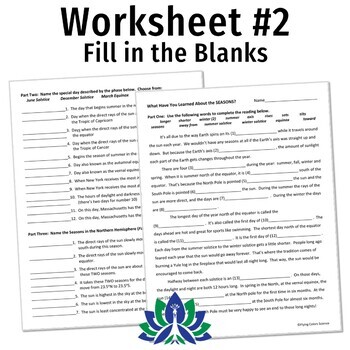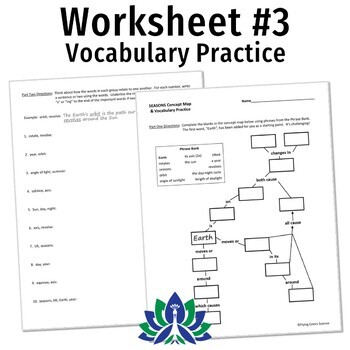Reason for the Seasons Worksheet Bundle NGSS MS-ESS1-1
- Zip
- Google Apps™
- Easel Activity

Products in this Bundle (3)
Bonus
Also included in
- Never search for "something to do tomorrow" ever again! This bundle contains PRINT AND GO lessons, NO PREP activities, LOW PREP labs, and ENGAGING articles to supplement and thoroughly enhance an Earth and space science course. Every included resource is easy to implement, standards-based, and high-Price $399.99Original Price $639.06Save $239.07
Description
Get 3 of our most popular SEASONS worksheets plus a FREE BONUS! Each worksheet reviews Earth’s movement and motions in space and how they create seasons.
BUNDLE INCLUDES:
- Seasons Diagram Analysis Worksheet
- Seasons Review Worksheet
- Concept Map & Vocabulary Practice Worksheet
- FREE BONUS: Direct vs. Indirect Light Worksheet
- FREE BONUS: GOOGLE OPTION TO ASSIGN
INDIVIDUAL RESOURCE DESCRIPTIONS:
Seasons Diagram Analysis Worksheet: Have students analyze a diagram of Earth's orbit to demonstrate their understanding of seasons. Each question requires students to analyze the diagram for:
- Earth's tilted axis
- Seasons
- Earth's movements and motions in space
- Rotation versus revolution
- Equinoxes and solstices
- The concentration of light hitting Earth
Seasons Review Worksheet: Review seasons and Earth's movements and motions in space.
- Part One: Fill in the blanks in paragraphs about the tilt of the axis, the length of days, etc.
- Part Two: Review the solstices and equinoxes.
- Part Three: Reviews key features of the four seasons.
Concept Map & Vocabulary Practice Worksheet: Get kids THINKING - not your typical vocabulary sheet!
- Part One: Students complete a concept map with provided vocabulary words.
- Part Two: Students write sentences to relate sets of vocabulary words to each other. This gets them to think about the terms beyond the definitions!
Compare Indirect vs. Direct Light: This QUICK resource gives students a set of 15 phrases such as "spread out", "concentrated", "overhead" etc. and they must write the phrase under either the column "indirect sunlight" or "direct sunlight". There are also 2 simple diagrams to categorize, as well.
Teacher Notes:
- INCLUDES ANSWER KEYS
- Please note: These resources are NOT editable.
⭐You may also be interested in our Seasons ACTIVITY BUNDLE!⭐
⭐⭐⭐Click here to get 5 FREE EARTH & SPACE SCIENCE lessons!⭐⭐⭐






